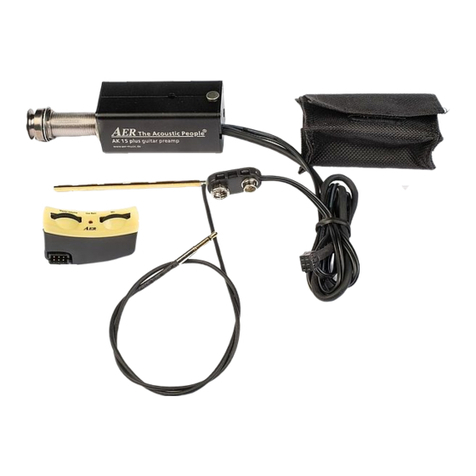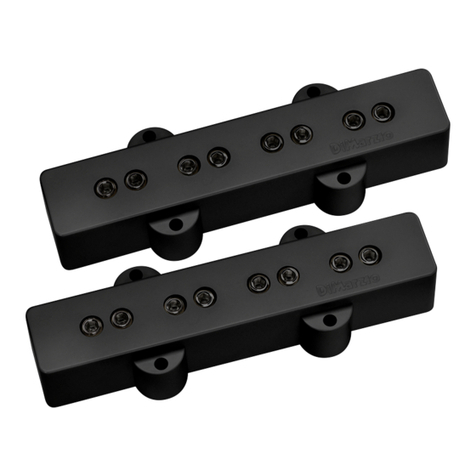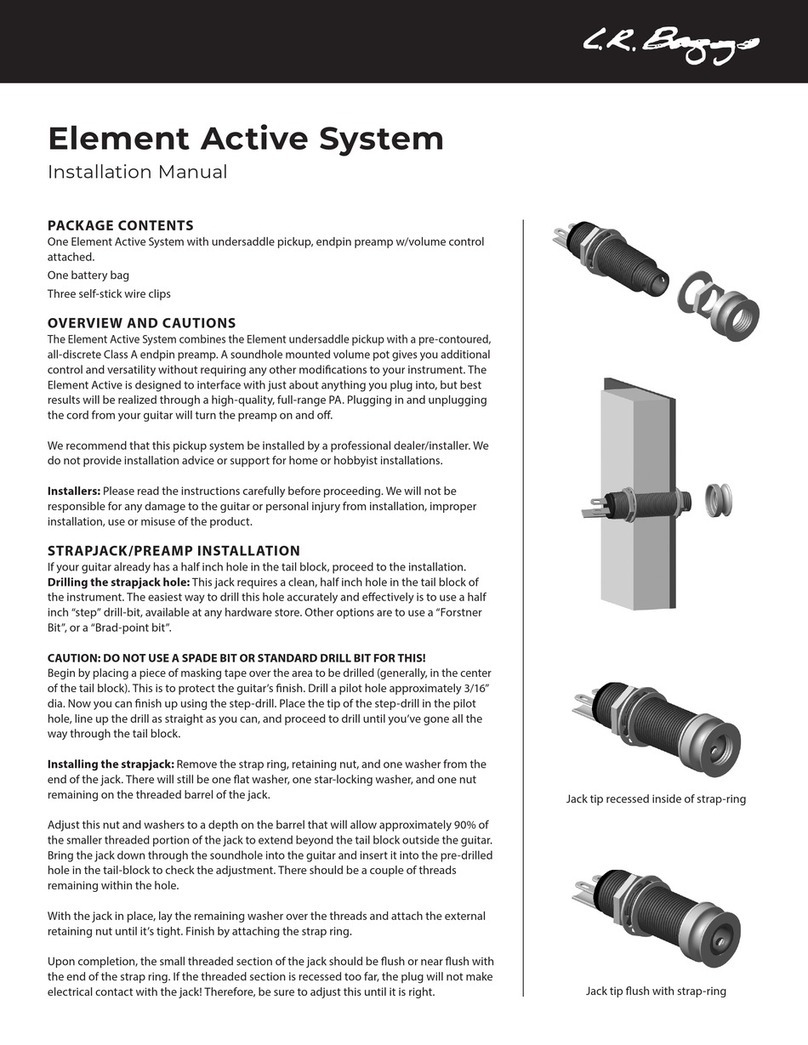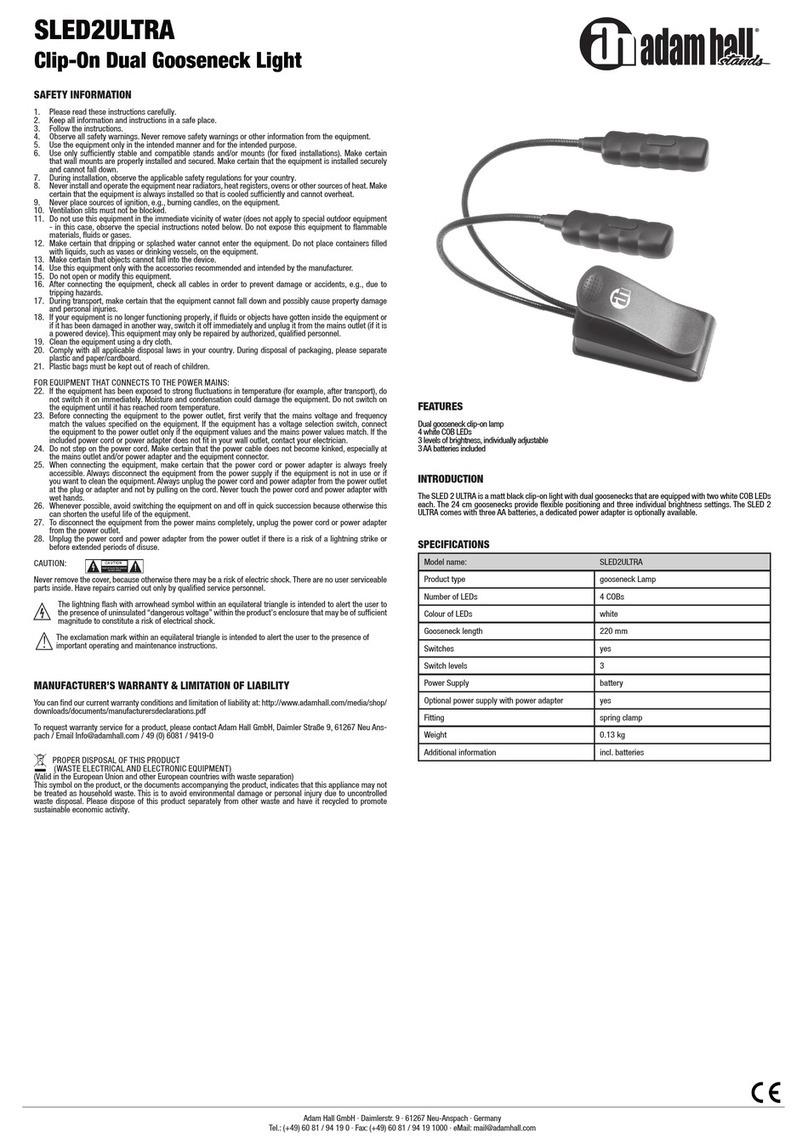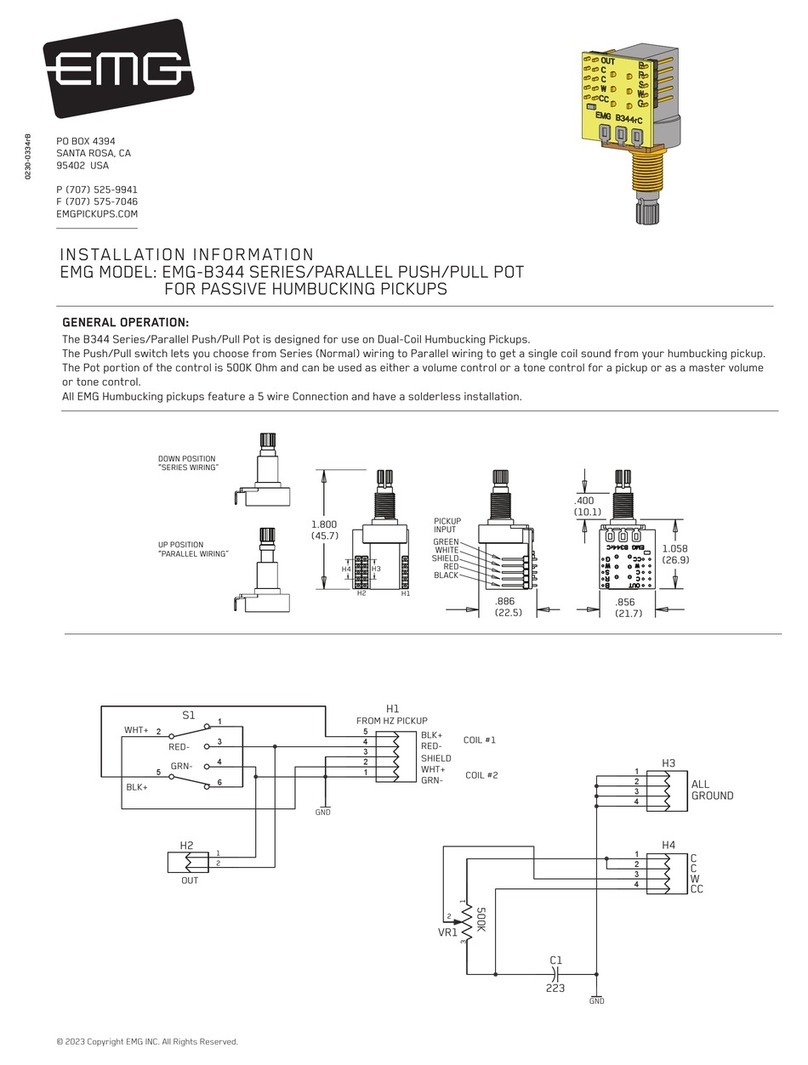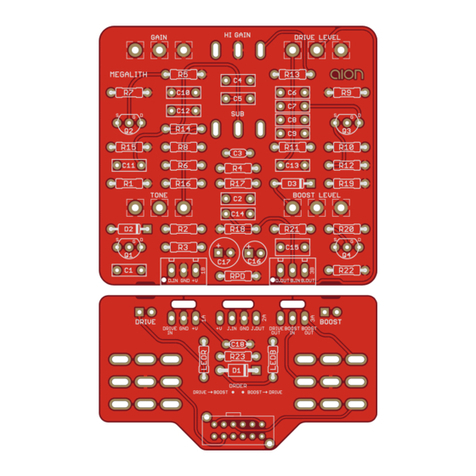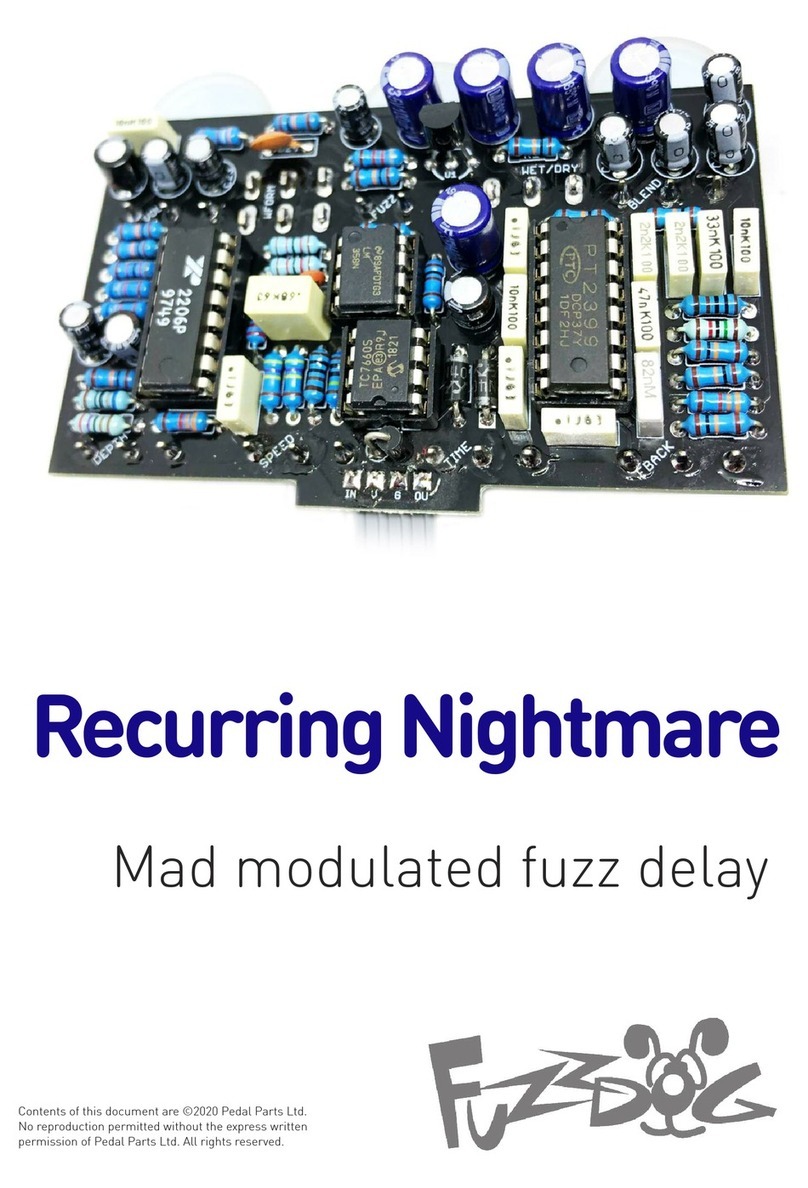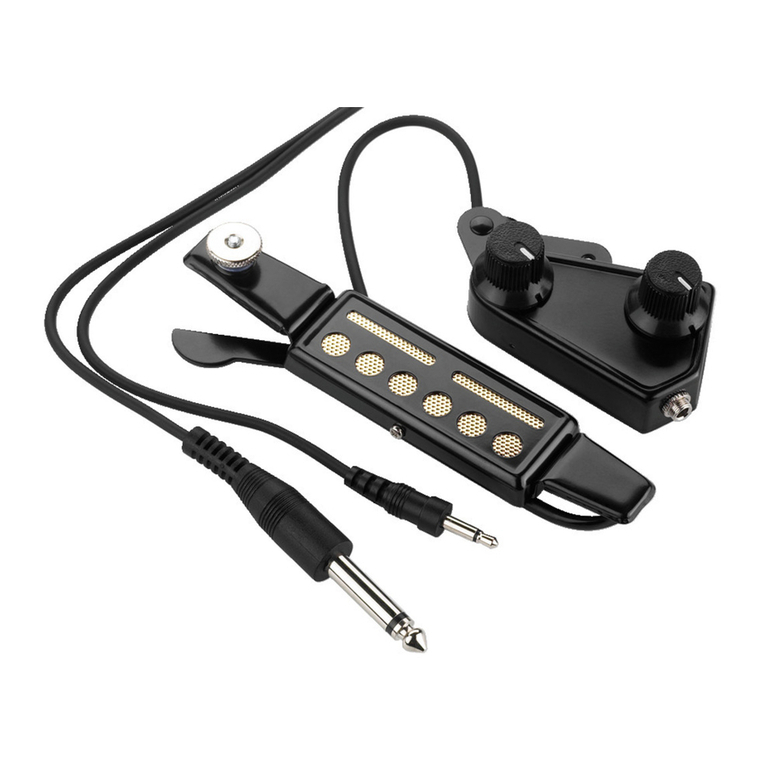AER Lily one User manual

P
Twin Source Rechargeable Pick Up System for Acoustic Instruments
Installation guide

Thank you for choosing AER‘s new
PickUp System Lily one.
After long times of trial end error, listening to
musicians needs, we developed an new pickup
system which stands for brilliant reproduction
and matches the highest demands for the natural
amplication of your instruments’ dynamics.
The innovative battery solution guarantees hours
of playing without the need to change batteries.
All you have to do is charge the internal battery
with the enclosed USB-jack cable.
Lily one is a two source system: An undersaddle
piezo crystal pickup combined with a high-end
MEMS microphone integrated in the endpin
pre-amp.
Lily one provides high volumes and impressive
punch combined with low noise components for
best possible signal to noise ratio as you migh
know from our AK 15 plus system.
Lily one is one step ahead.
Lily one can be used with all guitars and other
instruments which allow under saddle pickup
installation with string spacings from
10 to 12.5 mm.
The installation is similar to all under-saddle
pickup systems. The instrument does not suer
mechanical stress in use or during installation.
There is no soldering necessary.
Read on and have fun using Lily one

Checklist
Check the contents of the package to make
sure everything is complete:
• 1 x Lily one piezo pick-up with 2.5 mm jack
• 1 x Lily one endpin preamp with integrated
microphone, soundhole control (SHC)
with installed battery
• 1 x adhesive tape for SHC
• 3 x cable clamps
• Manual/Instruction guide
• 1,5 m USB-Jack charging cable
1. General requirements
• Check the string spacing, centre to centre
of the string, or middle between a pair, to
make sure it matches Lily one.
• Make sure that the saddle has a minimum
width of 2,3 mm. The undersaddle pickup
is 2,3 mm wide.
• Check the string pressure on the pickup
crystal by assuring a minimum 20° break
angle, if more all the better. If your instrument
does not provide this, the string slots
will need ramping (done by a luthier).
• Fitting the Lily one soundhole control (SHC)
• Check the inside of the guitar to identify
the ideal position for the Lily one SHC on the
bass side of the soundhole for easy operation
while performing.
• Bracing around the soundhole diers
between makers and can conict with the
control unit. Some guitar constructions requi-
re an underlay to glue the SHC on properly. In
any case should the gluing surface be at and
free of dust or grease.

2. Installing the Piezo-Pickup
Caution: the pickup-strip is delicate.
Avoid bending this component.
• Check that the top bracing does not con-
ict with the projected pickup cable hole
through the saddle slot.
• Verify that the slot depth (including pick-
up) always remains more than half of the
total saddle height. Not enough space for
the saddle can cause bridge cracks.
Check with your qualied luthier.
• Make sure that the pickup ts the slot and
does not tilt within.
• Check the saddle. The materials, bone,
Delrin® and Micarta® require dierent
attention. You may consider getting
a replacement saddle to work on, keeping
the original untouched.
The saddle-slot needs to be completely
at and the saddle rectangular and at.
Even if both are at, some adjustments
towards pickup signal balance may be
necessary. In some cases the balance
between the strings of the acoustic instru-
ments is not even – the pickup just reects
this and needs compensation to increase
the string-pressure.
Loosen the strings and clamp them with
e.g. a capo to prevent them hindering you
at your task. Remove the string-pins, the
saddle and the endpin. Depending on
what work needs to be done, use paper
masking tape to protect the surface of
your instruments around bridge and
endpin. Always check the tape for possible
residue on your guitar rst at a‘safe’spot.

3. Woodwork
• Drill or ream a 12 mm hole to t the end-
pin pre-amp. Make sure that it is centred
properly and in a 90° angle to the end
block.
• Then, drill a 2.5 mm hole through the
saddle slot and the top of the guitar at the
edge of the slot. It is immaterial which side
is drilled, bass or treble side.
Avoid hitting the braces!
• For installing the piezo pickup there
should be no routing required if the slot
has a regular length and depth!
The width and depth should be sucient.
• Take the piezo pickup and lead the mini-
jack through the hole in your instrument.
The piezo will t most saddle slots easily.
The 6 piezoelectric crystals sit underneath
the strings, they don‘t have to be centred.
You can use the cable as a spring to keep
the pickup in place. Make sure the saddle
slides easily into the slot, however it
should not tilt. [Paragraph ist doppelt]
• Fixate the saddle with masking tape to
protect the piezo pickup during installati-
on, and use a strip of masking tape to stick
the piezo pickup cable inside the guitar to
a near top brace, as strain relief.
• The saddle will sit higher now that the
piezo is installed. For proper playing
action, remove some material from the
saddle. Use double side tape to xate
sanding paper to a completely at surface
and sand o enough material from the
bottom of the saddle to match your play-
ing requirement. Always check that the
bottom of the saddle stays at.

4. Endpin Mounting
• After drilling the 12 mm hole in the guitars
end block, guide the preamp unit into the
sound hole and slip the pre-amp endpin
through the endpin hole and preselect
the correct position with the hex counter
nut inside the guitar. Then x the endpin
nally with the second hex nut from the
outside, pushing an allen key through the
hole in the thread for use as lock against
twisting. When the endpin is safely xed,
screw on the strap-button.
• Now plug the piezo pickup connector
into the piezo socket of the endpin, there
should be an audible„click“, to make sure
it sits rmly. The internal microphone
is best pointed towards the back of the
guitar.
5. Soundhole Control Unit
• Now connect the soundhole control unit
with the small connector. You can then
connect the output jack to an amplier.
Plugging the jack into the endpin socket
closes the circuit and switches on the
Lily one system, without jack there is no
battery power consumption. Even when
not playing, the system will lose battery
power when a jack plug is connected.
• Factory settings:
Piezo: +10dB
Microphone: +10dB
• Check the sound of the piezo pickup rst
and listen if all strings sound equally loud.
Imbalance in string volumes should be
addressed by a luthier, or follow the tips in
the trouble shooting section.

Now add microphone signal by turning
the Mic control. Tapping the top will let
you hear the microphone signal very
easily. Sounds good?
• Continue with the next step.
Bear in mind:
The Lily one system is not made for
‚microphone-only‘ performance! The
microphone will add denition and
authenticity as well as an acoustic
ambience, which makes the sound more
natural. Too much microphone signal will
make the tone‚hollow‘ and can cause
feedback. The piezo at full volume may
make microphone use impractical.
If you can hear both signals loud and
clear you can x the cable with the cable
clamps.
6. Soundhole
Final assembling
Depending upon the construction of the
instrument, you may nd it necessary to
use dierent materials to underlay or pad
the soundhole control. First dry-t the
control unit to determine the position.
If adhesive tape is used, make sure to
degrease both surfaces. Position the SHC
where you can reach it easily and x the
cable in a safe position. With the instru-
ment in playing position, the left pot (in
the direction of the bridge) should be
the master volume, the left pot (in
the direction of the neck) adds the
microphone signal.

Now, after degreasing the position
of the cable clamps, x these to
the side of the guitar and secure
the cables to avoid unwanted
rattling noises.
7. Operation
Lily one is a very powerful system,
which combines a strong piezo si-
gnal with an additional micropho-
ne signal. It is designed to blend
the microphone to the pickup for
overtones and more liveliness. You
can make use of the whole range
of the SHC microphone control to
almost maximum, depending on
your personal sound preferences.
Please consider:
the optimum range of this control
is between 30 and 60% rotation!
Full volume is neither necessary
nor recommended. Adding the mi-
crophone volume will yield a more
natural and lively sound. Too much
microphone signal can cause
feedback, lower the microphone
volume if this occurs. Plugging the
jack into the endpin-socket closes
the circuit and switches the system
on. Without jackplug the system is
switched o and there is no active
battery consumption.

8. Troubleshooting
No piezo signal
Make sure you have connected the
jack connector properly.
No mic signal
Too much or too little mic signal
The microphone master level is
pre-adjustable independently at
the preamp and controlled with
the soundhole control (master
volume + added microphone
level). If you have trouble dialing
in the right amount of micropho-
ne signal, if you feel there is too
much microphone signal, or not
nearly enough, we have a solution
for that.
If you have so much mic signal
that you can’t use the soundhole
control to get the right amount
in the mix, or if the soundhole con-
trol is fully open and you still could
use more mic signal is the only
time to use this internal control.
No output signal
Ensure that the battery still has
enough charge to operate the
system. The indicator light on the
soundhole control unit will light
up red if the battery is low.
In this case, use the enclosed char-
ging cable to recharge the battery
while using a standard Power/USB
charger (from your cellphone)

Sometimes a loose strap holder
maylead to a contact fault in the
endpin socket. There are aftermar-
ket solutions with straplocks for
acoustic guitars that may prevent
this.
Uneven balance
Attention to proper string balance
is a normal issue with all pickup
systems – more or less obvious –
depending e.g. on the dynamic
range of the system. Just listen to
your instrument as it is without
pickup and play each individual
string one after the other with
the same impulse. You may nd
that the natural reproduction of
the strings is already uneven. Just
one example of many reasons for
uneven reproduction.
How to react:
If you don’t have a luthier at hand,
go through the following steps:
Assuming the installation of the
saddle is correct, all surfaces are
even and straight and the pickup
is working properly, you can add
layers of scotch tape to the saddle
at weak positions to increase the
pressure on relevant crystals.
To nd the proper balance may
require a little extra time and work
which is annoying for everyone –
especially the installer – but it has
to be done – there is no way to
evade it!

In general
We have designed the Lily one
system to produce the clearest and
most dynamic sound possible.
This high dynamic output means
that your battery life will be less
long than with other mainstream
systems.
The Lily one battery management
will safely indicate when rechar-
ging is recommendable soon. If the
Batt-Low LED (red) lights up, you
still have about 1.5h of operating
time left.
Just charge your instrument with
the enclosed cable and your USB /
Power connector.
Our high output volume is suited
for all amplication systems.
Good sound is an inspiration for
life. We hope we can contribute to
this with Lily one

Africa, America, Asia, Oceania
aer music gmbh
Haberstrasse 46
D-42551 Velbert
info@aer-music.de
aer amplier gmbh
Haberstrasse 46
D-42551 Velbert
info@aer-amplier.com
Europe
www.aer-music.de
Other manuals for Lily one
1
Table of contents
Other AER Accessories For Musical Instruments manuals
Popular Accessories For Musical Instruments manuals by other brands

ILITCH ELECTRONICS
ILITCH ELECTRONICS CVNCS-JR User manual and installation instructions

Fishman
Fishman FLUENCE TIM HENSON SIGNATURE Series installation guide
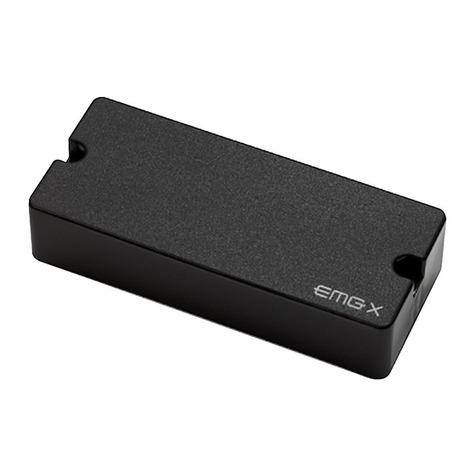
EMG
EMG X Series Installation information
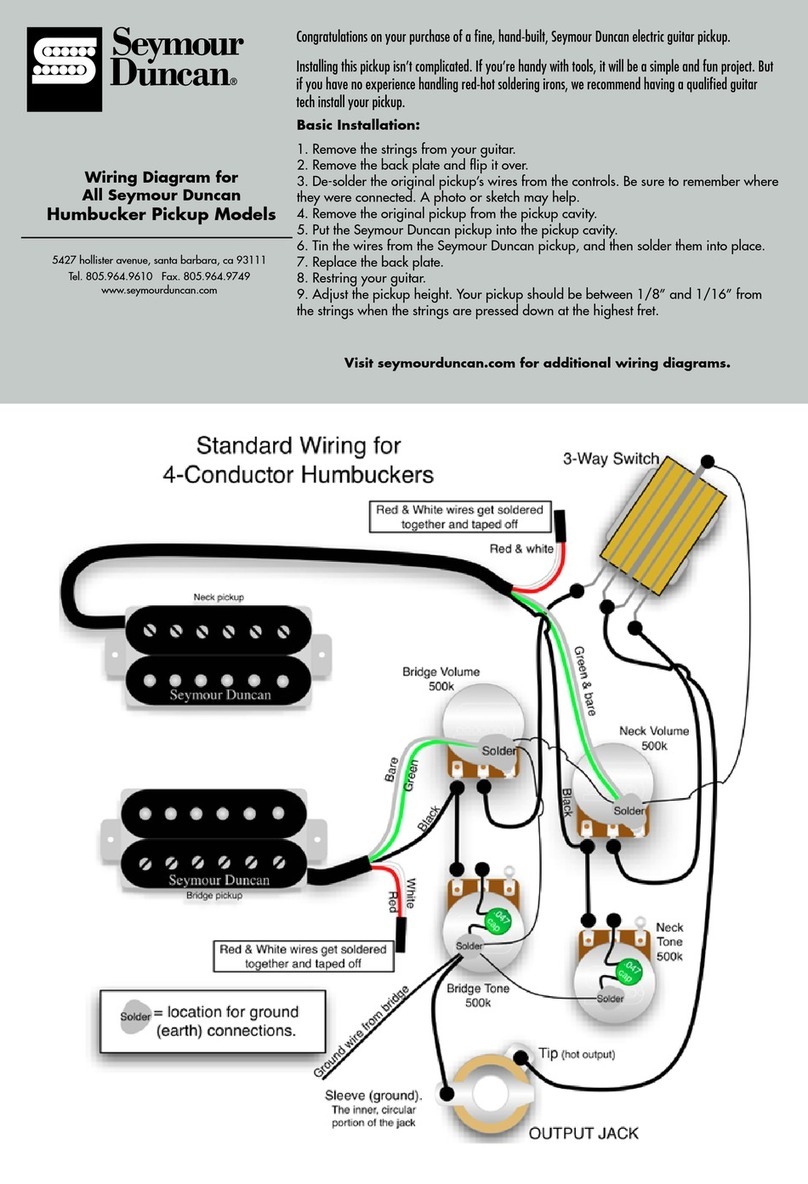
Duncan
Duncan SH-8n Invader Wiring diagram
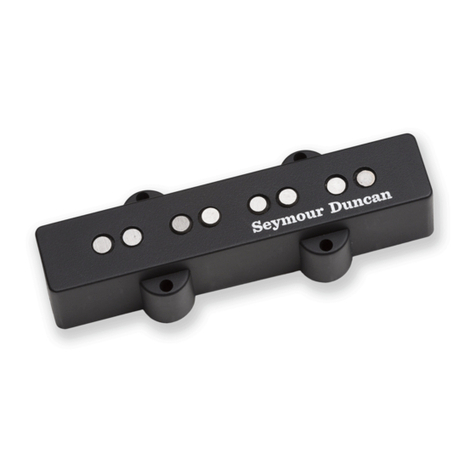
Duncan
Duncan Apollo Jazz Bass - neck Wiring diagrams

Duncan
Duncan HyperSwitch manual

